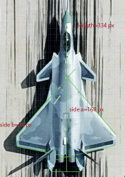Damn that short display is way more impressive than the dog and pony show they give us at Zhuhai.Spinning to the moon
You are using an out of date browser. It may not display this or other websites correctly.
You should upgrade or use an alternative browser.
You should upgrade or use an alternative browser.
J-20 5th Generation Fighter VII
- Thread starter siegecrossbow
- Start date
- Status
- Not open for further replies.
Since we now have official length and wingspan numbers for the J-20 we can calculate the J-20's actual reference wing area. To do this I basically divided the reference wing area in half into two congruent trapezoids (formed by the leading edge and trailing edge lines drawn all the way to the centerline of the fuselage), and used the trapezoid area formula ((a+b)/2)*h. For the total length of the aircraft in the picture I measured ~334 pixels. I measured the length of side a to be ~168 pixels, and side b to be ~24 pixels. Using 21.2m as the real length, side a = (168/334)*21.2 m = 10.66 m. Side b = (24/334)*21.2m = 1.52 m. The height h in this case is half the wingspan, which using the given 13.1m would make h = 6.55 m. ((10.66+1.52)/2)*6.55 = 39.89 m^2. Double that for the total wing area and you get 79.78 m^2. Obviously these measurements aren't perfect so attach some error bars to the calculation, but more or less the J-20 seems to be within ballpark of the F-22's wing area, if not slightly bigger.
Attachments
I get a lower 77.5 m^2 if you use the center aircraft (less longitudinal distortion) as opposed to the aircraft in the front. So you have roughly the same wing area as the F-22, except the F-22 is a tailed unstable aircraft.
Tail vs canard: in unstable parts of flight regime, canards subtract lift, tails add lift, in stable parts of flight regime, canards add lift, tails subtract lift. Once again, we go back to the J-20 being designed for high-speed maneuvering as opposed to low-speed maneuvering, or the canards being used to enhance high-speed cruise lift at the cost of low-speed (max turn rate ITR/STR) performance.
Tail vs canard: in unstable parts of flight regime, canards subtract lift, tails add lift, in stable parts of flight regime, canards add lift, tails subtract lift. Once again, we go back to the J-20 being designed for high-speed maneuvering as opposed to low-speed maneuvering, or the canards being used to enhance high-speed cruise lift at the cost of low-speed (max turn rate ITR/STR) performance.
Damn that short display is way more impressive than the dog and pony show they give us at Zhuhai.
It is a part of the dog and pony show at Zhuhai. People just didn't notice because it literally disappeared into the clouds.
There was an aerodynamics thread specifically set up for your "theorizing":I get a lower 77.5 m^2 if you use the center aircraft (less longitudinal distortion) as opposed to the aircraft in the front. So you have roughly the same wing area as the F-22, except the F-22 is a tailed unstable aircraft.
Tail vs canard: in unstable parts of flight regime, canards subtract lift, tails add lift, in stable parts of flight regime, canards add lift, tails subtract lift. Once again, we go back to the J-20 being designed for high-speed maneuvering as opposed to low-speed maneuvering, or the canards being used to enhance high-speed cruise lift at the cost of low-speed (max turn rate ITR/STR) performance.
Aerodynamics thread
I created this thread at Blitzo's request so we can stop cluttering threads about specific fighters with aerodynamic explanations, questions, and debates.
www.sinodefenceforum.com
- Status
- Not open for further replies.

















